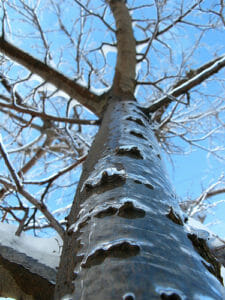 A sudden cold snap last December damaged many fruit trees in Hood River, The Dalles, and northeastern Oregon. Some parts of the Mid-Columbia area saw temperatures dip below zero. Regional experts say such a damaging freeze hasn’t hit the area since 1955. Trees weren’t prepared for such cold temperatures at that time of year. In just a few days, conditions went from sixty degrees to five degrees or less. This killed many young trees and damaged spur wood. According to the East Oregonian, some growers near Milton-Freewater have already removed trees killed by the cold spell.
A sudden cold snap last December damaged many fruit trees in Hood River, The Dalles, and northeastern Oregon. Some parts of the Mid-Columbia area saw temperatures dip below zero. Regional experts say such a damaging freeze hasn’t hit the area since 1955. Trees weren’t prepared for such cold temperatures at that time of year. In just a few days, conditions went from sixty degrees to five degrees or less. This killed many young trees and damaged spur wood. According to the East Oregonian, some growers near Milton-Freewater have already removed trees killed by the cold spell.
As Portland certified arborists, we’d like to dive into the biology behind why this cold snap caused such extensive fruit tree damage. Typical spring freezes damage blossoms. As this thorough chart from the Michigan State University extensions program shows, the extent of freeze damage depends upon bud development stage. At the swollen bud stage, for instance, sweet cherries can withstand 30 minutes of 23-degree temperature without damage. On the other end of the blossom spectrum, sweet cherries in full bloom can take 30 minutes of 29-degree weather without damage. Orchard managers are accustomed to freezing temperatures affecting blossoms themselves, and as such they know how to respond to keep fruit trees healthy and maximize blossoming.
However, last December’s frigid temperatures caused serious damage to fruit trees’ spur wood, which is the short twig on older branches that produces blossoms. Mike Omeg of Omeg orchards has found damage to 1-, 2-, and 3-year-old spur wood. The spur wood connects fruiting buds to the branch. Its connective tissue carries nutrients to the blossoms. By cutting back branch sections, orchard managers can get a visual understanding of freeze damage. Green and white tissue with no browning indicates no damage. However, Omeg and others have found that some spurs are showing browning caused by cold. Brown tissue appears after cells freeze and burst open. The brown tint is caused by sugars and other leaking cellular contents. That brown tissue is dead. Because the spur cells are so important in transporting nutrients to buds, orchard managers are concerned that their trees may not be able to bloom at all if spur damage is extensive.
Omeg recommends that orchard managers modify their pruning program to accommodate this freeze damage. First, he recommends that Hood River and Portland tree services get a sample of every orchard block. By categorizing spur and bud samples from each block of trees as healthy (all white and green tissue), damaged (some brown tissue), or dead (no visible green, almost all brown tissue), managers can make decisions about how to go forward with pruning.
If all the spurs on a branch are dead, that branch is finished. Buds will never grow there again because there is no way for the spurs to transfer nutrients. So it makes sense to cut away dead spur branches. However, this must be balanced with harvest costs. If too many branches are cut away, the orchard will have no way to stay economically viable, as there will be too few cherries to harvest and sell. Additionally, orchard managers must keep a close look out for borer insects and canker disease, which are likely to exploit weakened fruit trees. (This is also a smart thing to inquire after with your own local tree service.)
Portland, OR consumers could be seeing a reduced number of stone fruits (peaches, cherries, and plums) this spring, due to the spur wood damage from December’s cold temperatures. Apples growth could be hampered as well. Industry experts say we should expect 25% less sweet cherry production in the Mid-Columbia area. That could potentially drive up fruit prices.
To protect weakened trees from diseases, Omeg is planning a proactive approach of copper spray application. Copper is an effective spray for preventing many fruit tree diseases. However, overusing copper spray can cause a toxic build-up of copper in the soil. If you’re concerned about the health of your fruit trees, give us a call. Our professional arborists will be happy to visit your property and recommend effective solutions.
This post first appeared on https://www.urbanforestprofessionals.com